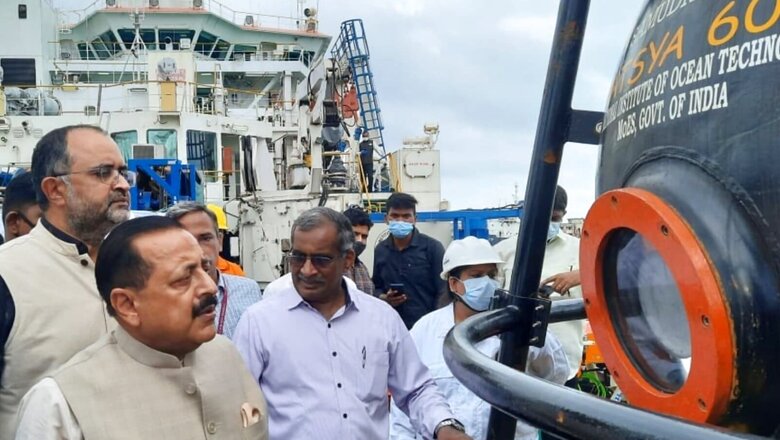
views
Surrounded by the seas in the West, South and East, India is blessed with a coastline of over 7,500 km. Keeping this in mind, India launched its first manned ocean mission, ‘Samudrayan’, to further its exploration of the seas under its Deep Ocean Mission devised in 2018. With this, India joined an elite club of nations, such as USA, Russia, Japan, France and China, having such underwater vehicles for carrying out subsea activities.
Earlier in June, the central government approved the Deep Ocean Mission to be implemented by the union ministry of earth sciences at a total budget of ₹4,077 crore for five years.
India’s relationship with its coastline has long affected its economy, politics and socio-cultural setup. But its time to look beyond with a deep dive into research and studies with this mission. The depths of the seas have much more to offer, as India’s exclusive economic zone (EEZ) spreads over 2.2 million sq km and in the deep sea, lies “unexplored and unutilised”, according to information provided on the website of the principal scientific adviser (PSA). According to the government of India, the sea mission will also help understand and mitigate the crisis of climate change.
The mission was launched on October 29 by union minister Jitendra Singh at National Institute of Ocean Technology (NIOT). He tweeted pictures of ‘Sagar Nidhi’, a state-of-the-art research vessel that will be a part of Samudrayan. He said other institutions will also be integrated to develop technologies for the mission and explore possibilities of mining, biodiversity, clean energy and fresh water.
Glimpses from 'Sagar Nidhi',India’s state of the art, ice-class research vessel Ship,sailing from #Chennai Port.Other institutions will be integrated to develop technologies for Deep Ocean Mission & to explore possibilities of mining, bio-diversity,clean energy, fresh water etc. pic.twitter.com/ubET3VNfr0— Dr Jitendra Singh (@DrJitendraSingh) October 30, 2021
Singh also sailed in Sagar Nidhi from Chennai port, interacted with scientists and discussed versatile projects in progress. Singh also said India had made huge progress in science and technology and when an Indian went up into space as part of Gaganyaan programme, another would dive deep into the ocean.
Here’s all you need to know about India’s first manned ocean mission ‘Samudrayan’:
1. Under the Deep Ocean Mission, undertaken by NIOT, the Samudrayan project aims to send people into the deep sea in an indigenous submersible vehicle.
2. Matsya 6000, the deep sea vehicle, under Samudrayan is under development in collaboration with Indian Space Research Organisation. It is capable of carrying three human beings in a titanium alloy sphere of 2.1-metre diameter enclosed space with an endurance of 12 hours and an additional 96 hours in case of emergency situation.
3. The niche technology facilitates carrying out deep ocean exploration of non-living resources such as polymetallic manganese nodules, gas hydrates, hydro-thermal sulphides and cobalt crusts.
4. Matsya 6000 will be ready for qualification trials by December 2024, according to a NIOT official.
5. Scientists inside Matsya 6000 will be able to explore oceans and survey the ocean bed and collect data and samples.
6. Indigenous efforts are underway at NIOT towards design of the vehicle and some of the subsystems are realised from Indian as well as from global market towards its special usage in high pressure deep sea environment.
7. The NIOT developed a “personnel sphere” made of mild steel with local industry for an operational capability of 500 m and tested for its usage as per International Classification and Certification Agency for man-rated operation during this month’s sea trial using Sagar Nidhi in Bay of Bengal.
8. The deep sea vehicle shall be manoeuvered at deep sea floor with six degree freedom using battery powered propulsion system for four hours at 6000-m depth.
9. The vehicle is a platform to carry any devices, sensors to deep sea for doing experiments/observations in the presence of a human being.
10. This programme shall augment India’s capability with infrastructure facility such as high thickness welding facility and deep ocean simulator.
A NIOT official said during the course of the programme, new skill sets were being added under the capacity building that would pave the way for industry development within the country under ‘Atmanirbhar Bharat’.
“System design, concept of operation, subcomponents functionality and integrity, emergency rescue, failure mode analysis are reviewed and certified as per the rules of International Association of Classification and Certification Society for man-rated usage of manned submersible at a depth of 6000 metres,” according to a press release issued by NIOT.
(With PTI inputs)
Read all the Latest News , Breaking News and IPL 2022 Live Updates here.


















Comments
0 comment